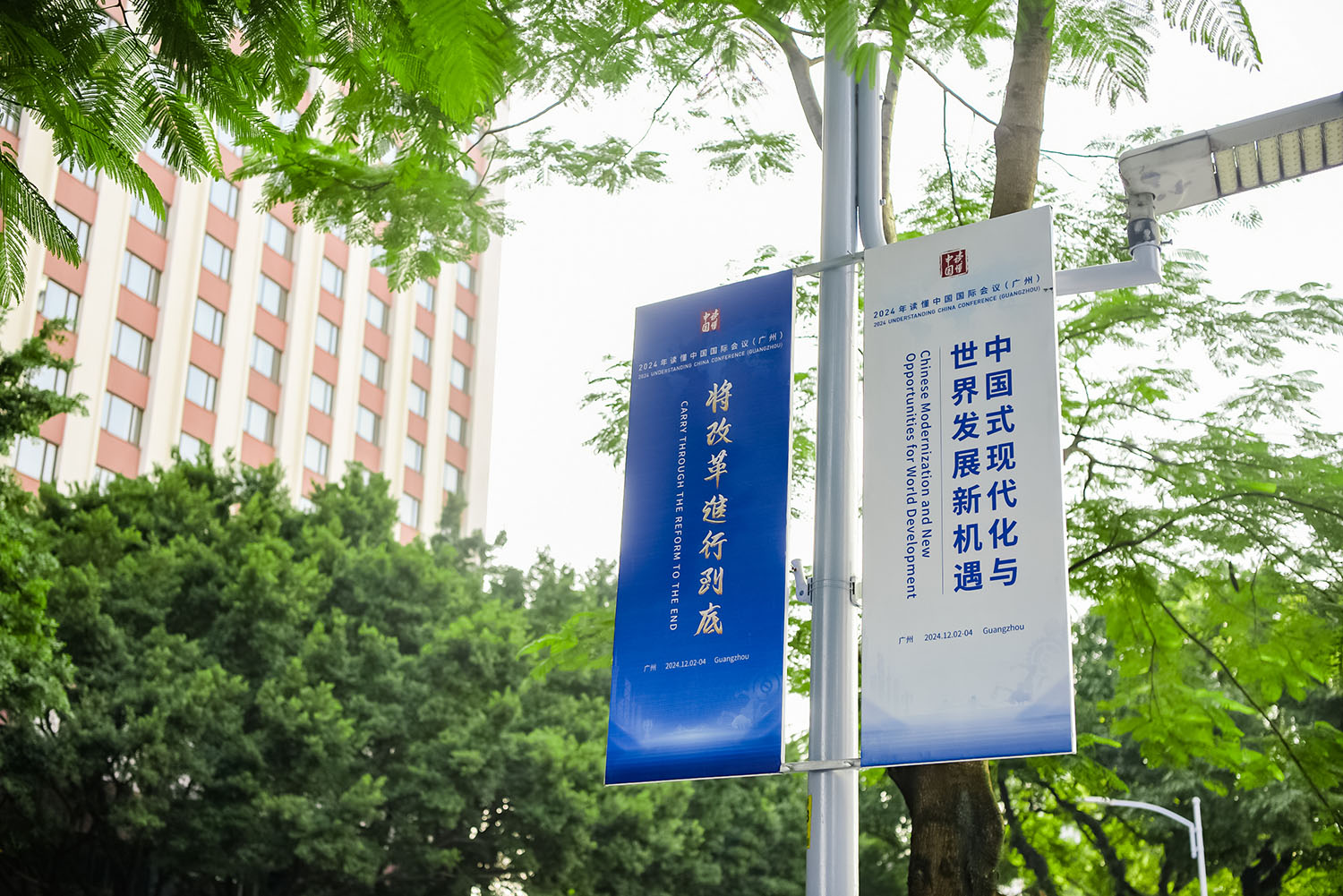Area's high-quality development widely acclaimed by intl conference guests

Participants in the 2024 Understanding China Conference gave a thumbs-up for the high-quality development of the Guangdong-Hong Kong-Macao Greater Bay Area.
As one of the most dynamic and innovative areas in China, the GBA is taking the lead in promoting Chinese modernization. Its development path was in the spotlight when Guangzhou, capital of Guangdong province, played host to the three-day international conference, which concluded on Wednesday.
Zhang Chuanwei, board chairman of Mingyang Group headquartered in Zhongshan, Guangdong province, has his own success story to share. Mingyang specializes in the development and operation of new energy, related machinery research and production, and engineering technology and services.
READ MORE: Greater Bay Area rides wave of sci-tech collaboration
When he started the company more than 30 years ago, there were just seven staff, Zhang recalled. "Thanks to China's unwavering commitment to reform and opening-up, and thanks to the great practice of Chinese modernization, the clean energy produced by Mingyang nowadays can cater to a city of 25 million people, equivalent to the size of Guangzhou, for 20 years."
The business of his company covers dozens of countries in Asia, Europe, Africa, the Americas and Oceania, he added.
China's new energy industry, especially technological equipment for the sector, has taken a development path from following overseas peers to outpacing them, and the country is now the world's largest manufacturer and installer of new energy machinery, Zhang noted.
Some 80 percent of global solar energy installation technology and equipment, and 50 percent of the world's wind power technology and equipment come from China. The country has become an important driver of the global energy development transformation, he said.
The company is determined to promote energy conservation and emissions reduction, create a world-class offshore energy belt for the GBA, and make its contribution to Chinese modernization that achieves harmonious coexistence between humans and nature, he said.
Wang Tong, member of the expert committee of China Southern Power Grid, said that with the concept of green development, China, especially the GBA, has made substantial progress in the field of new energy, demonstrating the country's resolute commitment to promoting green, low-carbon and sustainable development.
China is focused on building a new energy-supply system to support its modernization, contributing "Chinese wisdom" to the world for common prosperity, Wang said.
Chen Yongkang, deputy head of the Guangdong Department of Justice, said the province has issued regulations to promote sci-tech innovation, and will advance local legislation in more areas, such as the low-altitude economy, artificial intelligence and big data, to help provide an innovation-friendly environment for tech-driven businesses.
Vu N. Duong, director of the Air Traffic Management Research Institute at Nanyang Technological University of Singapore, said China is at the forefront of the low-altitude economy, especially in the GBA, which along with the entire country has huge development potential.
The GBA has a long-term advantage in trade, which provides a solid foundation for the development of the low-altitude economy, he added.
The economic aggregate of the 56,000-square-kilometer GBA has been on the rise since its outline development plan was released more than five years ago, with the figure surpassing 14 trillion yuan ($1.92 trillion) in 2023.
At a seminar during the Understanding China Conference, guests said that the GBA is a strategic pivot of the new development pattern, a demonstration area for high-quality development and a leading area for Chinese modernization.
Guo Yuewen, secretary of the Party group of the Guangdong Academy of Social Sciences, said that in recent years, Guangdong has leveraged the driving role of the development of the GBA, focusing on promoting creative and leading reforms at a higher starting point.
The four major cooperation platforms of Hengqin, Qianhai, Nansha and Hetao have introduced thousands of original reform measures, with a focus on rule alignment and mechanism integration. Hundreds of reform and innovation experiences have been promoted at the national, provincial, and municipal levels.
A widespread transport network is now in operation after major infrastructure projects were completed. That witnessed a closer bond and a growing flow of passengers and goods in the GBA.
The Shenzhen-Zhongshan Link's traffic volume exceeded 10 million vehicles in 118 days since its opening at the end of June. Since the Hong Kong-Zhuhai-Macao Bridge was put into use in October 2018, the number of inbound and outbound road passengers has reached more than 60 million. The area's combined port throughput ranks first in the world, with Guangzhou Port, Shenzhen Port and Zhuhai Port, among others, joining the ranks of the large ports each handling at least 100 million metric tons of goods.
ALSO READ: Guangdong expressway cuts down travel time
Guangzhou Port and Shenzhen Port have opened container routes linking more than 300 ports in more than 120 countries and regions.
Seven airports are in service across the GBA. With the commissioning of more aviation infrastructure projects, it is estimated that the airport network in the GBA will have an annual passenger throughput of 420 million by 2035.
Since 2018, major transportation infrastructure projects such as the Guangzhou-Shenzhen-Hong Kong high-speed rail and the Hong Kong-Zhuhai-Macao Bridge have been completed. The operational and under-construction rail transit mileage in the GBA now exceeds 5,400 kilometers.
When it comes to scientific and technological innovation, the GBA is home to two national laboratories, 30 key national-level laboratories, 430 key provincial-level laboratories, and other laboratory platforms, Xinhua News Agency reported.
The Shenzhen-Hong Kong-Guangzhou sci-tech cluster has ranked among the best worldwide for five consecutive years.
Environmental protection is another focus of regional cooperation. Hong Kong and Macao continue to improve their cooperation mechanism for ecological protection with Guangdong under the framework of "one country, two systems", implementing a "shared protection and shared benefits" model.


